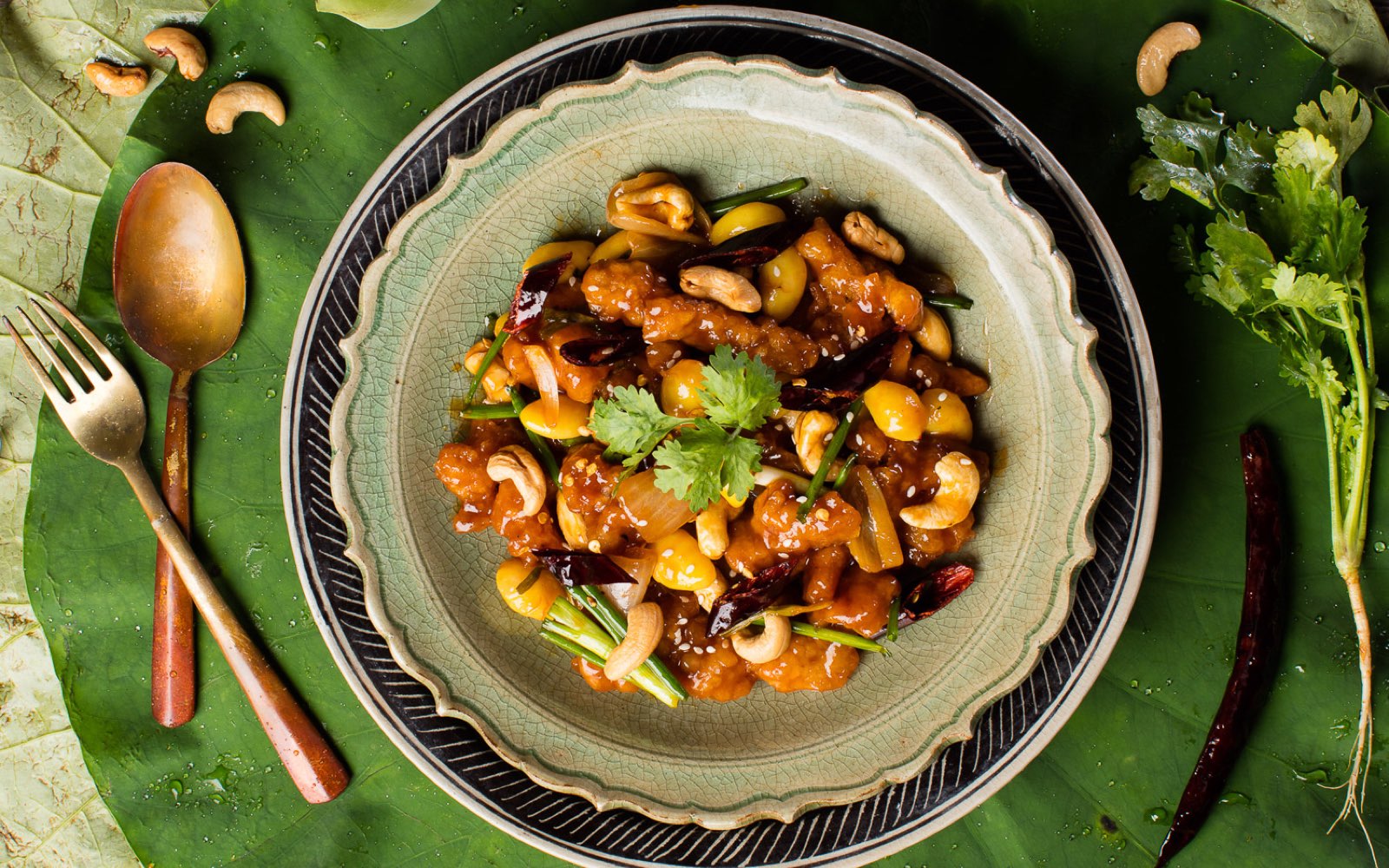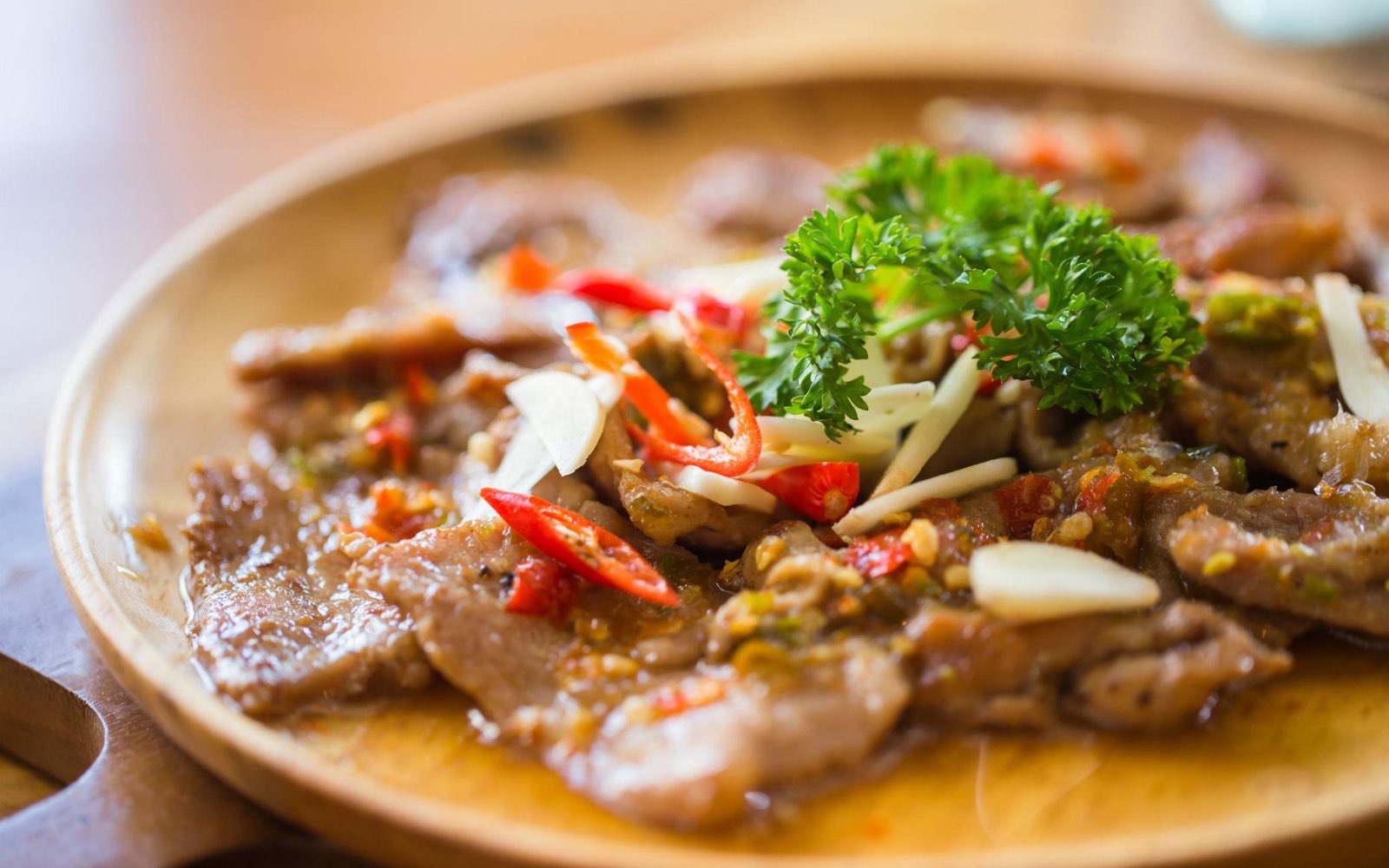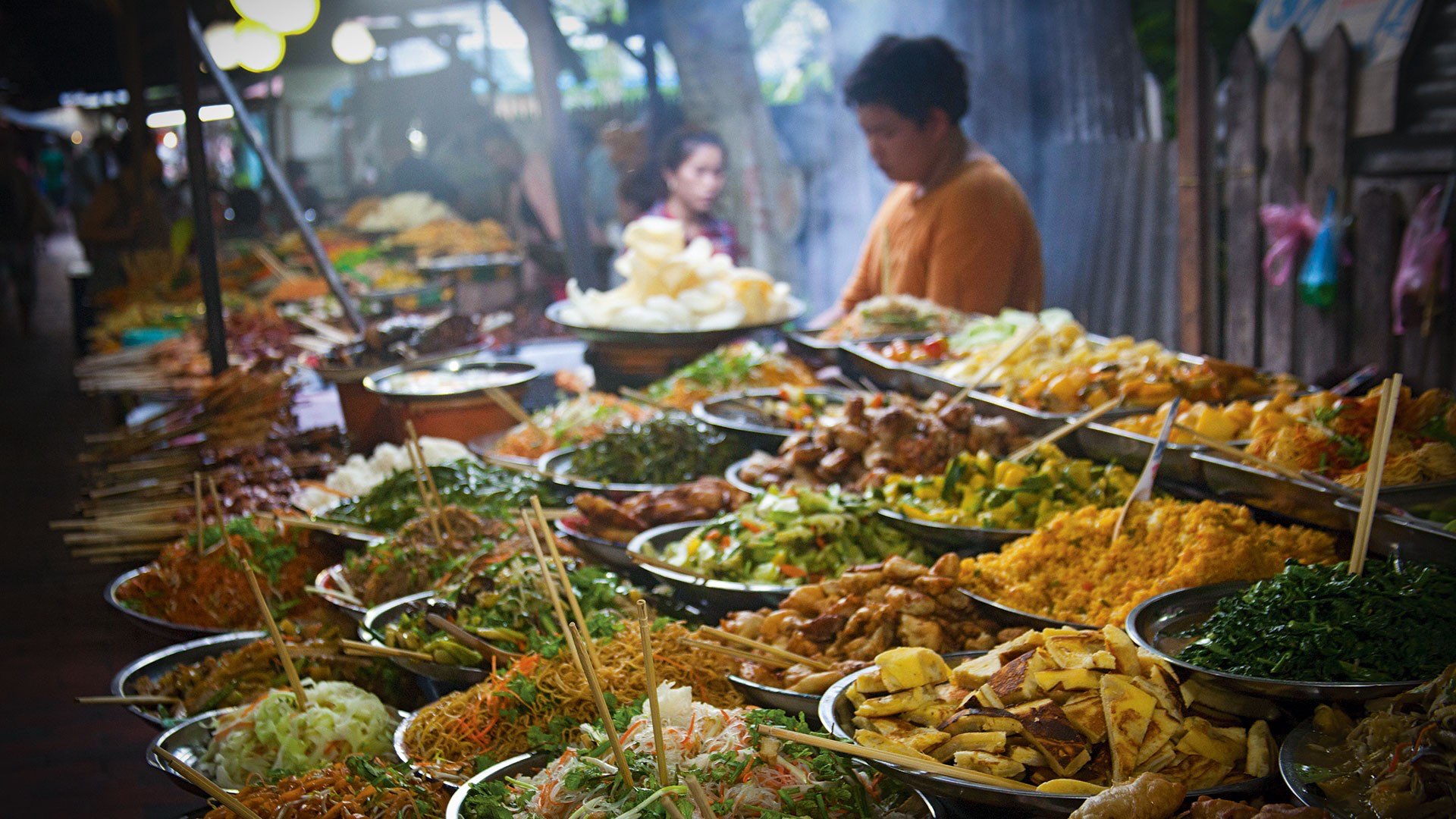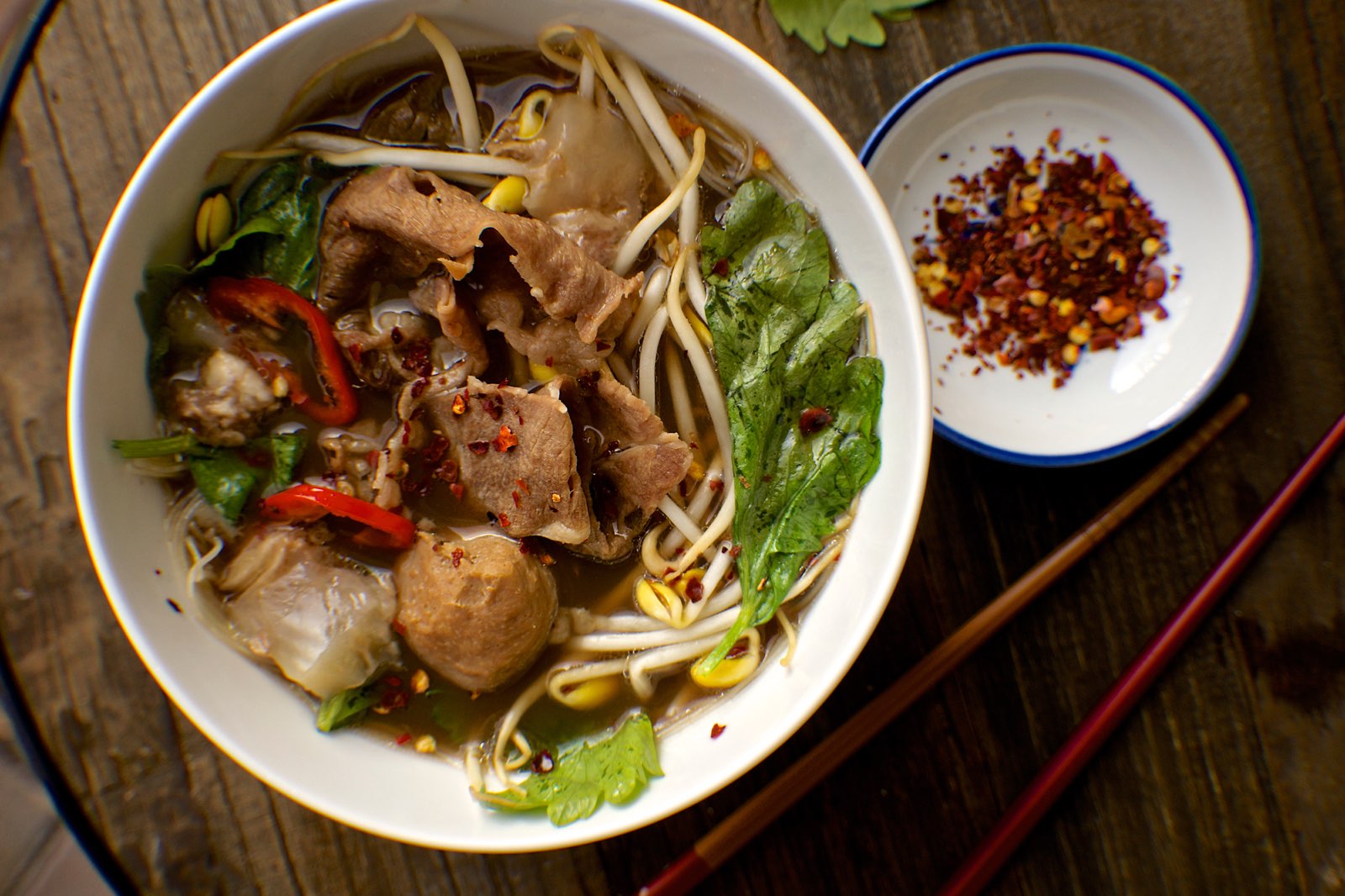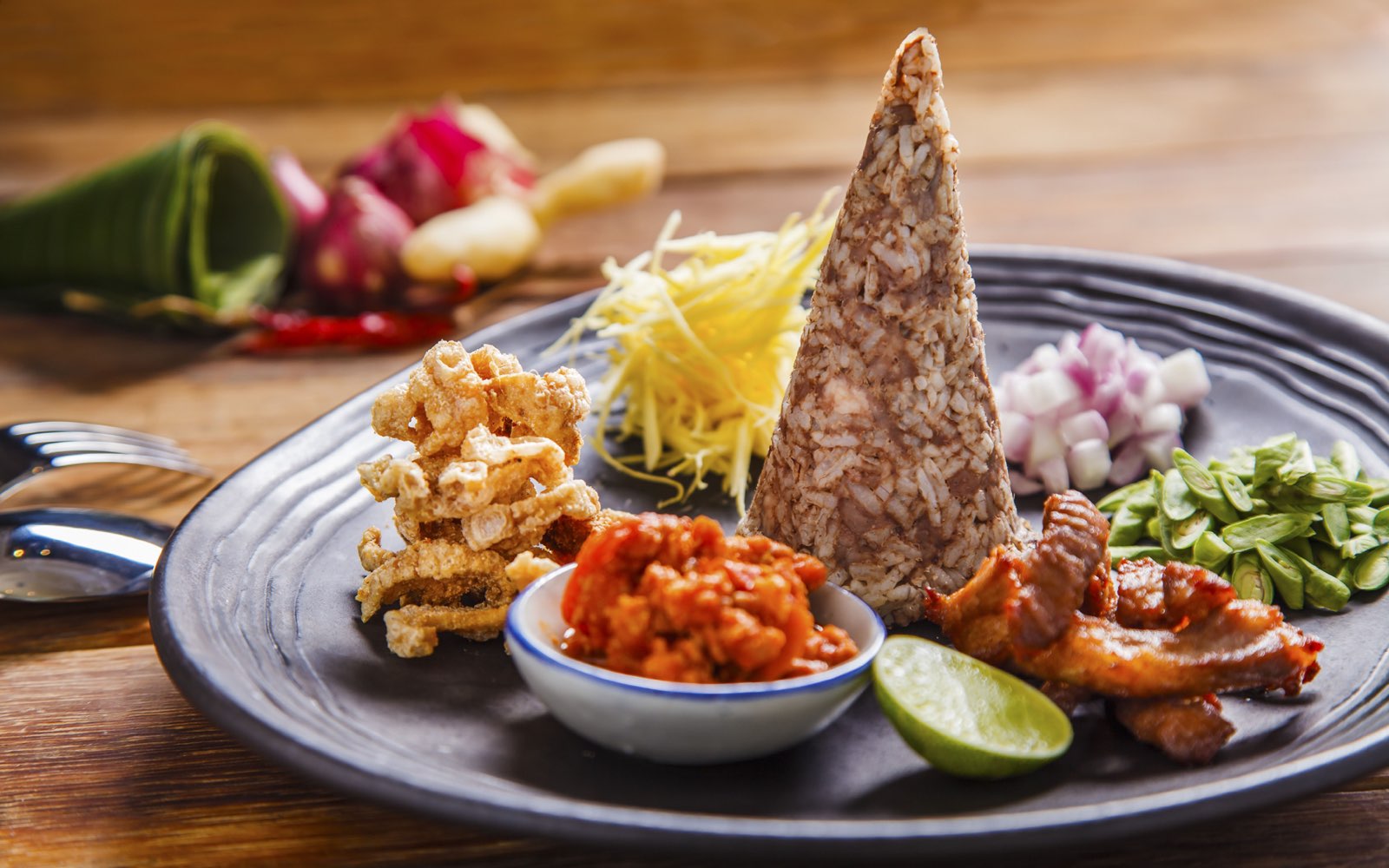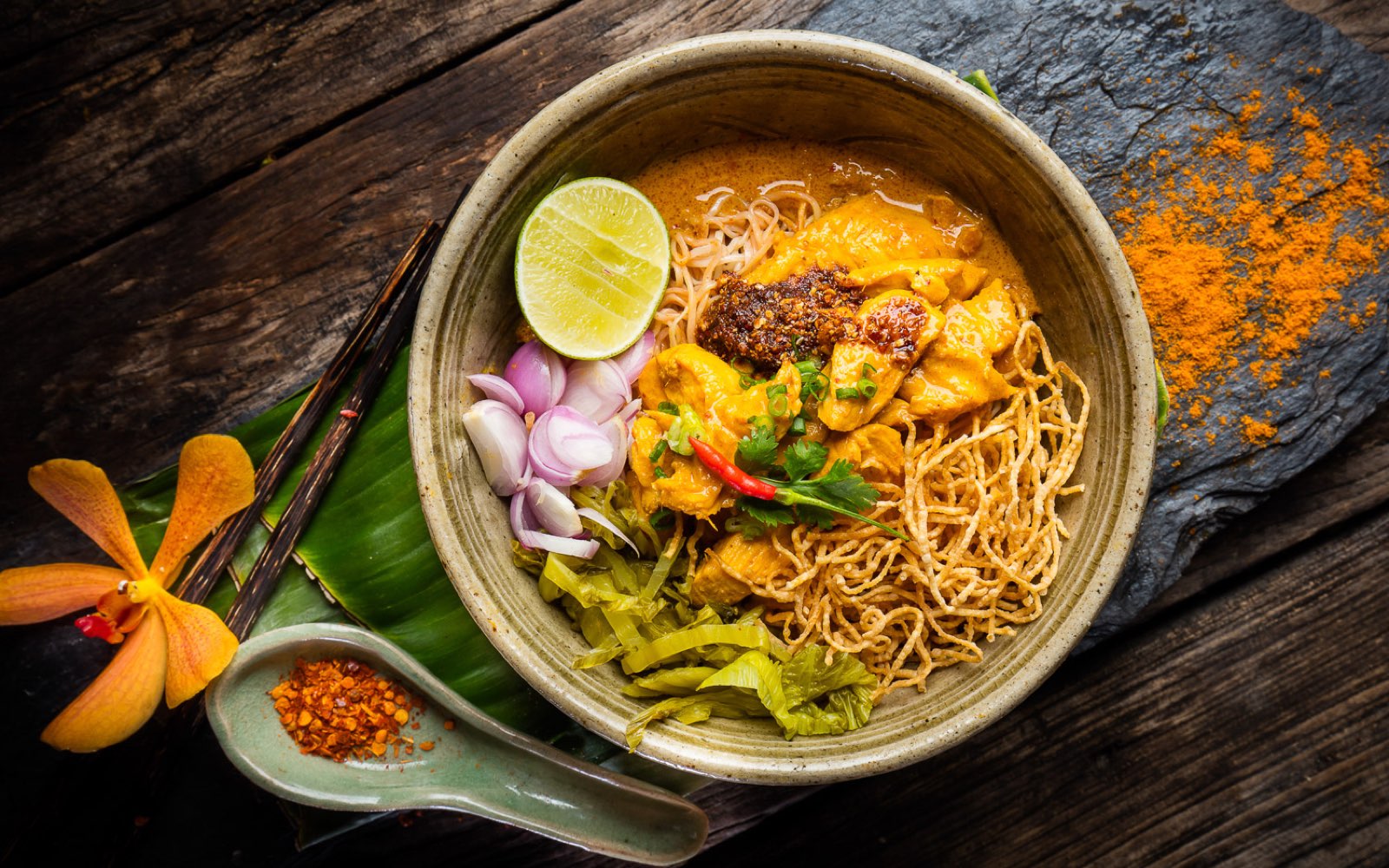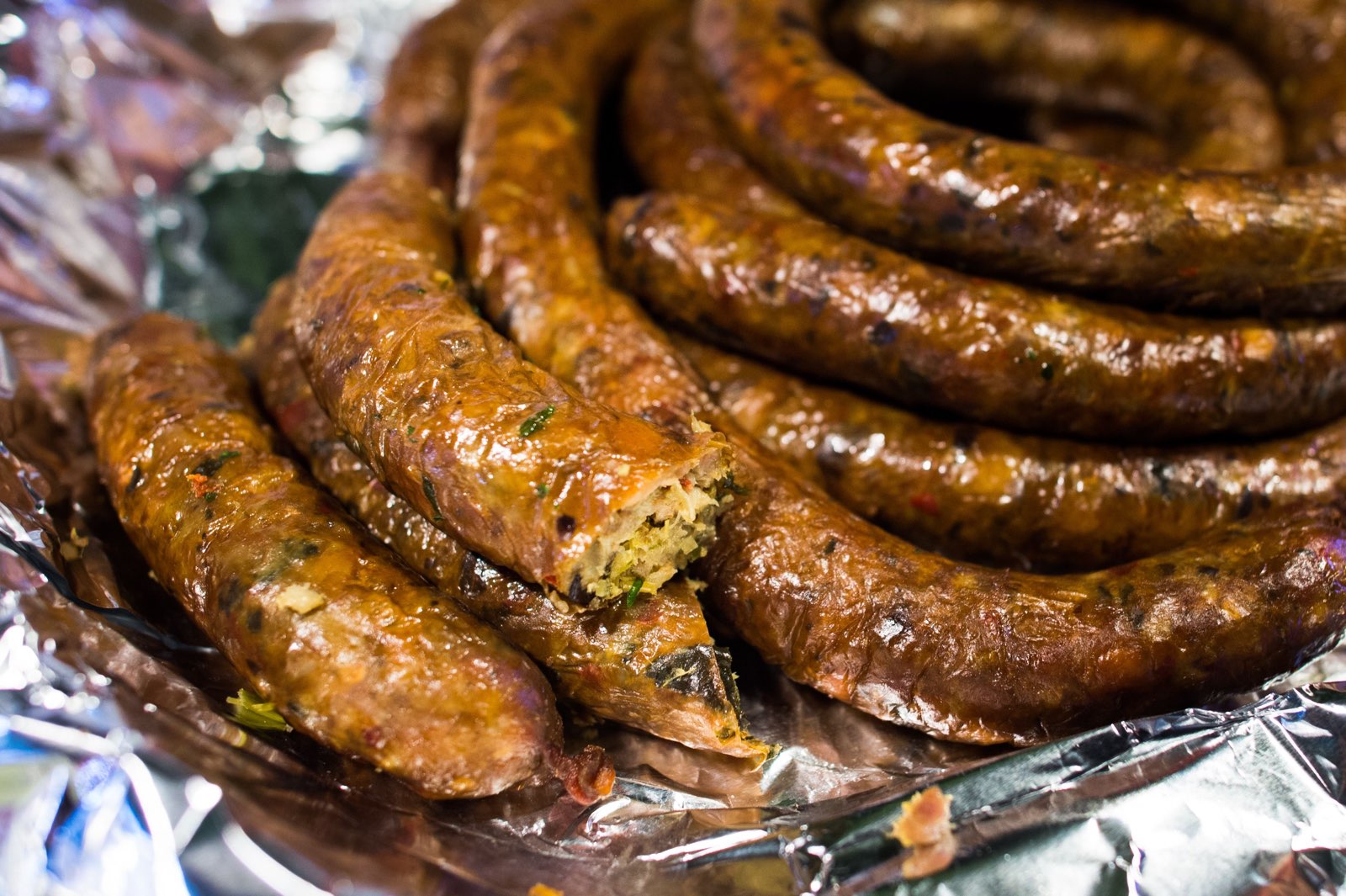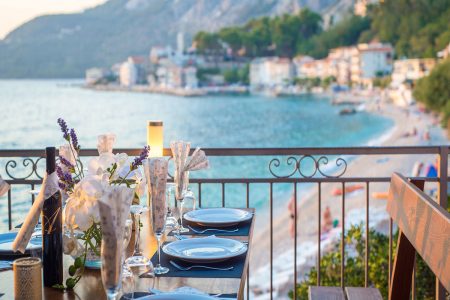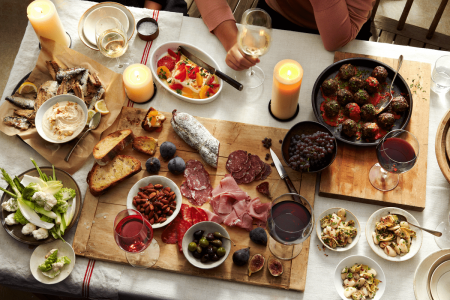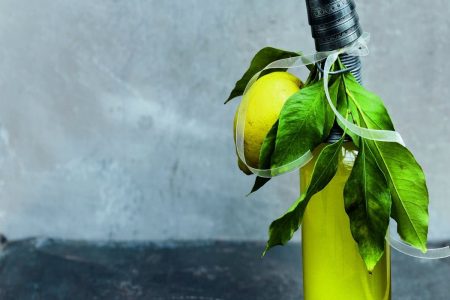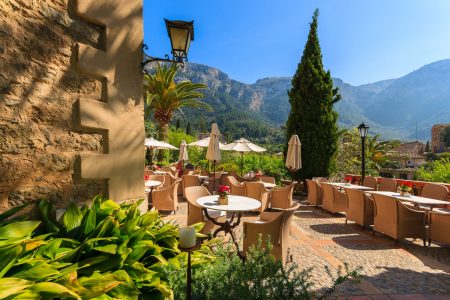Spicy Tom Yum Soup, green papaya salad, and fried rice. Think you know everything about Thai food? Thailand’s cuisine duffers in form and taste in every province, and the dishes of Northern Thailand are no exception.
Northern Thailand cuisine differs from what you tried at southern resorts, and maybe even in Bangkok. Local dishes are not as spicy as their southern “fellows”: they do not always contain volcanic chili and coconut milk. Northern food is indicative of the region’s cooler climate, which dictates another product package and way of cooking, not to mention a love for meat, seasonal veggies and love to all things deep-fried: chicken with cashews, pork with garlic and pepper, and vegetables in oyster sauce. You will find all that in your plate accompanied by sticky rice. You can make balls of it and dip them in the sauce.
Northern Thailand cuisine differs from what you tried at southern resorts, and maybe even in Bangkok.
Vegetables, meat, rice and sauce. Food seems very simple, doesn’t it? But you have no idea how many variations of dishes they may cook of these products in Northern Thailand. Their cuisine has one more secret – there are always four flavours: spicy, salty, sour, and sweet. The right balance of these elements gives the body all the energy it needs. Perhaps it is this perfect balance that makes Thais are smooth-tempered, good-humored and do not pay attention to the things that may bowl you down.
You can try most of the authentic dishes at small street stalls. Their look can cause a panic attack, but in fact you may easily tell how tasty the dishes are by the crowd. Alas and alack, there are relatively few restaurants serving northern-style dishes outside large cities in the region. But if you manage to come across a more or less nice restaurant, be sure that any of the dishes of our Top 7 are worth trying.
Vegetables, meat, rice and sauce. Food seems very simple, doesn’t it? But you have no idea how many variations of dishes they may cook of these products in Northern Thailand.
Gaeng Hung Lay
Actually, it is Burmese in origin but Thais liked it so much that until now it is one of their favourite dishes. This curry unites fatty pork, a mild spice mixture, ginger and garlic. Gaeng is a usual dish on special occasions: at festivals and ceremonies – and in Northern Thailand restaurants every day. So if you are going to try it for the first time, you will enjoy a fantastic kaleidoscope of tastes and odours. The dish will surprise you with its pleasant spicy and mild taste, which is fundamentally different from the hot Indian analogues.
Gaeang is a usual dish on special occasions: at festivals and ceremonies – and in Northern Thailand restaurants every day.
Where to find. Try Gaeng Hung Lay at Mae Si Bua Restaurant in Mae Hong Son. To work up an appetite walk a little around this provincial mounting town: admire the reflection of a Buddhist temple in the lake, bathe in rejuvenating hot springs, get a load of local people. This is the region where Shan people live, whose culture, traditions and cuisine are more Burmese than Thai. When you get hungry, visit Mae Si Bua Restaurant. Auntie Bua, the owner and chef, cooks fantastic Gaeng Hung Lay and amazing soups. The menu here is only in Thai, but do not worry: just stab a finger at the picture you like, and you will get it “materialized”.
Auntie Bua, the owner and chef, cooks fantastic Gaeng Hung Lay and amazing soups.
Kuaitiao Sukhothai
It is unlikely that you will be able to pronounce this at once. But you may fix it all. Just a couple of second practicing and you will be able to make an order and get exactly what you want. (перекладено вище) (перекладено вище) Authentic Kuaitiao Sukhothai combines delicate noodles, a slightly sweet broth, pork (melting inside and brown and crispy outside), and long bean sprouts. It is garnishes of ground peanuts and thinly-sliced fresh herbs. Since the name includes Sukhotai, chances are great to find this speciality in the same-name city. In fact, there are two Sukhothais in the north of Thailand: one is ancient, with Buddha statues, lotus-covered pond, and picturesque ruins of temples, the other is modern, with a royal palace, sanctuary, cafes, hotels, and restaurants. Tourists usually stay in the second one and make sallies to the first Sukhotai. However, if you are not fond of ancient ruins, focus on the main things. I mean tasty ones.
Authentic Kuaitiao Sukhothai combines delicate noodles, a slightly sweet broth, pork, and long bean sprouts. It is garnishes of ground peanuts and thinly-sliced fresh herbs.
Where to find. Compare Sukhothai bowls at neighbouring Jayhae and Ta Pui. Whatever conclusion you come to, of course, both the first and second will be amazing. Gourmets say: “If you did not try noodles in Jayhae, you did not visit Sukhothai”. Although those who prefer Ta Pui argue that it was in their favourite café that this noodle, named after an ancient country, was first sold. Who is right? It’s up to you.
Gourmets say: “If you did not try noodles in Jayhae, you did not visit Sukhothai”.
Moo Thup
Take a tough cut of beef, marinade it, grill it, chop it into pieces, then thwack it with a sledgehammer until tender and you have Moo Thup, one of the more unique dishes in the northern Thai culinary repertoire”. This is the process of creating a specific North-Thai speciality in brief. Thup means to thwack and implies the technique of energetic hammer blows making tough pieces of meat to melt in your mouth. You can find this dish in Vietnam and Laos, but the Thai snack bar in Mae Sariang is very picturesque, and, what is more important, they cook perfect Moo Thup. In fact, this place has no name or any sign but any local resident will show you the way. You will see a typical northern Thai eatery: rustic, smoky, and visited mostly by men. But you will not notice all that when you try their Moo Thup. Except for pork version, they cook beef and buffalo Moo Thup as well as some exotic things like pork in banana leaves.
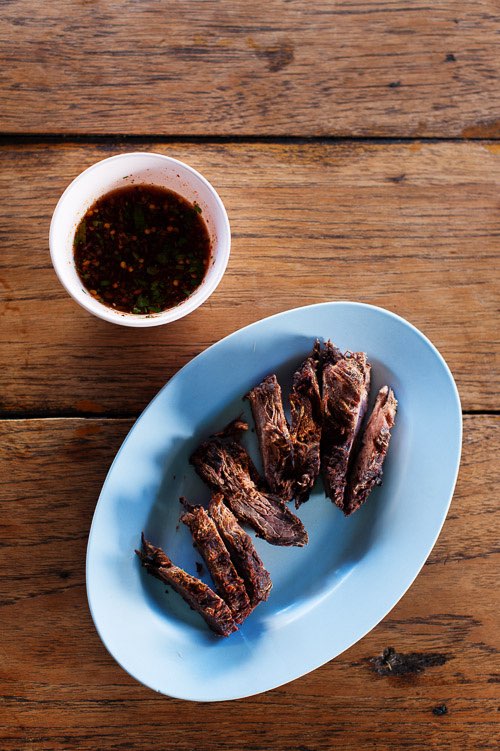
Moo Thup
“Thup” means to thwack and implies the technique of energetic hammer blows making tough pieces of meat to melt in your mouth.
Where to find. Try it in Mae Sariang. You will enjoy not only food but the city itself: quiet, provincial, located away from the tourism mainstream. That is why it is so attractive for silence-lovers and admirers of Northern Thailand’s exotic nature. There are many places to visit. There are several hill-tribe settlements on the one side and the jungles and Mae Ngao National Parks on the other side.
There are several hill-tribe settlements on the one side and the jungles and Mae Ngao National Parks on the other side.
Khao Kan Chin
When you learn of the ingredients of this snack, your first reaction will be a shock. But apart from prejudice and if you become a culinary experimenter, you will agree: yes, it is really tasty. Moreover, a ready dish is not red but is rather orange-colored like borscht. It is easy to understand why Thais consider Khao Kan Chin a great delicacy. This dish consists of rice mixed with blood and minced pork, steamed in a banana leaf package and served with a generous drizzle of garlic oil.
Blood-containing dishes is a peculiarity of Northern Thailand. Many of them are cooked of specific blood tofu (Blood Tofu, or “lyat” in Thai): it looks and feels like real tofu but actually it is coagulated blood. In Northern Thailand people buy it in stores and add to dishes. “Blood dishes”: Khanom Chin Nam Ngiao: noodles in broth with added pork blood, tomatoes, dry roasted chili peppers and red flowers with the strange name Kapok, Kuay Tiew Rua – just noodles in blood broth.
When you learn of the ingredients of this snack, your first reaction will be a shock.
Where to find. СChoose Chiang Mai for your experiments. The city is drowning in gardens, decorated with beautiful temples and has a block of museums and the largest night market in the north of the country. You will not find exotic dishes in tourist restaurants, but it is easy to get some on street stalls, in fast food cafes and floating markets.
Blood-containing dishes is a peculiarity of Northern Thailand.
Khao Soi
Khao Soi is probably as popular in Northern Thailand as pasta is in Italy. Actually it is a curry soup of rich yellow colour. A bowl with rich broth will be filled with delicate thin noodles, pieces of chicken and decorated with crispy egg noodles on top. Despite the seeming simplicity, all components of the dish create incredibly pleasant taste. Khao Soi is served with scallions, pickled cabbage and a slice of lime. In some places, they add coconut milk, which makes the flavour wonderfully creamy.
Despite the seeming simplicity, all components of the dish create incredibly pleasant taste.
Where to find. The origin of the curry noodles is closely linked to Chiang Mai, and was probably introduced to northern Thailand by travelling Chinese merchants. (переклад у попередньому сегменті) After all, Chiang Mai is the unofficial capital of Northern Thailand. This is a city with a well-developed tourist infrastructure, where you may find wonderful temples, parks, shopping malls, hotels, and restaurants. It’s a sin not to dive into Chiang Mai life for at least a day. And be sure to take time to get acquainted with local cuisine. Don’t forget: the most balanced and harmonic bowl Khao Soi is available at Khao Soi Prince, restaurant with almost the same name. The word Prince says a lot…
The recipe was probably introduced to the city by travelling Chinese merchants.
Nam Prik Noom
This is the dish that is most often recommended to tourists to cook by Thai cooking books, schools and YouTube videos. The reason is clear – this is one of the most favourite North-Thai dishes and those interested in local gastronomy can not stay away from trends. Nam Prik Noom contains long green chillies, shallots and garlic that are grilled until tender and then mashed into puree. The spicy paste of freshly cut grass colour is served with parboiled veggies, deep-fried pork and, of course, permanent sticky rice. We can’t do without it! The dish has a close relative with a similar name: Nam Prik Ong, but actually the difference is significant. It’s all about that “Ong”. Ingredients: tomatoes, chili and minced pork with veggies, herbs and permanent sticky rice.
Nam Prik Noom contains long green chillies, shallots and garlic that are grilled until tender and then mashed into puree.
Where to find. Gourmets believe that the best green Nam Prik Noom is served at Phu-Lae, in Chiang Rai. Thais love it for its authentic style, air conditioner and specialties like Khao Soi, which is served with original pork and herbs sausages. You will find much interesting in Chiang Rai itself as it is the starting point for exploring the notorious Golden Triangle. But of all the versions of Nam Prik Ong, the one that is cooked at Banpleng Restaurant in Mae Hong Son, is especially good. You can combine your journey to Chiang Rai and Mae Hong Son.
You will find much interesting in Chiang Rai itself as it is the starting point for exploring the notorious Golden Triangle.
Sai Ua
Northern Thailand, or rather Chiang Mai, is the motherland of sausages called Nam and Sai Ua. The first is minced pork seasoned with garlic and served with peanuts and fresh chili peppers. The second is ground pork with flavour added by lemongrass and some Thai mixture reminding adjika sauce. The coils of sausage are grilled and is the best when eaten hot. In fact, the dish is quite spicy but not too much. In our view, this is exactly what an appetizer to some strong drinks should look like. While on the other hand, having tried Sai Uae, some people will reconsider their culinary preferences in its favour.
Where to find. A unique version of Sai Uae is available at the old Mae Hae Restaurant in Lampang. It is rather unpretending, has no wifi and air conditioning, but it is clean, and the staff will always help choose from the menu in Thai. You can get to the restaurant in an original way – on a horse-drawn carriage. This transport is very popular in Lampang.
The grilled sausage is quite spicy but not too much.






